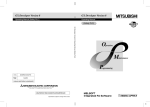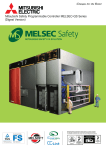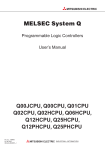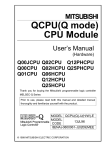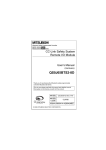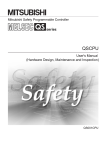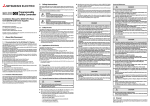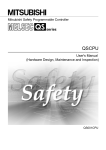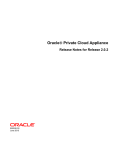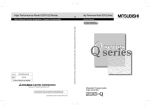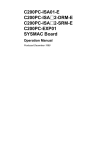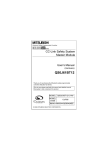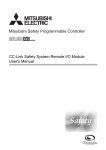Download QSCPU CPU Module User`s Manual (Hardware)
Transcript
Mitsubishi Safety Programmable Logic Controller
QSCPU
CPU Module
User’s Manual
(Hardware)
QS001CPU
Thank you for purchasing the Mitsubishi safety programmable logic
controller MELSEC-QS Series.
Prior to use, please read both this manual and detailed manual
thoroughly and familiarize yourself with the product.
MODEL
QSCPU-U-HW-E
MODEL
CODE
13JR91
IB(NA)-0800340ENG-B(0610)MEE
© 2006 MITSUBISHI ELECTRIC CORPORATION
z SAFETY PRECAUTIONS z
(Always read these instructions before using this equipment.)
Before using the product, please read this manual, the relevant manuals
introduced in this manual, standard PLC manuals, and the safety standard
carefully and pay full attention to safety to handle the product correctly.
In this manual, the safety instructions are ranked as "DANGER" and "CAUTION".
DANGER
Indicates that incorrect handling may cause
hazardous conditions, resulting in death or severe
injury.
CAUTION
Indicates that incorrect handling may cause
hazardous conditions, resulting in medium or slight
personal injury or physical damage.
Note that the
CAUTION level may lead to a serious consequence
according to the circumstances.
Always follow the instructions of both levels because they are important to
personal safety.
Please save this manual to make it accessible when required and always forward
it to the end user.
A-1
[Design Precautions]
DANGER
z When a safety PLC detects an error in an external power supply or a failure in
PLC main module, it turns off all the outputs. Create an external circuit to
securely stop the power of hazard by turning off the outputs.Incorrect
configuration may result in an accident.
z Create short current protection for a safety relay, and a protection circuit such
as a fuse, and breaker, outside a safety PLC.
z When data/program change, or status control is performed from a PC to a
running safety PLC, create an interlock circuit outside the sequence program
and safety PLC to ensure that the whole system always operates safely.
For the operations to a safety PLC, pay full attention to safety by reading the
relevant manuals carefully, and establishing the operating procedure.
Furthermore, for the online operations performed from a PC to a safety CPU
module, the corrective actions against a communication error due to a cable
connection fault, etc. should be predetermined as a system.
z All output signals from a safety CPU module to the CC-Link Safety system
master module are prohibited to use. These signals can be found in the
CC-Link Safety System Master Module User's Manual.
Do not turn ON or OFF these signals by sequence program, since turning ON/
OFF these output signals of the PLC system may cause malfunctions and
safety operation cannot be guaranteed.
z When a safety remote I/O module has detected CC-Link Safety error, it turns
off all the outputs. Note that the outputs in a sequence program are not
automatically turned off. If CC-Link Safety error has been detected, create a
sequence program that turns off the outputs in the program. If the CC-Link
Safety is restored with the outputs on, it may suddenly operate and result in
an accident.
z To inhibit restart without manual operation after safety function was performed
and outputs were turned OFF, create an interlock program which uses a reset
button for restart.
CAUTION
z Do not bunch the wires of external devices or communication cables together
with the main circuit or power lines, or install them close to each other.
They should be installed 100 mm (3.94 inch) or more from each other.
Not doing so could result in noise that would cause malfunctions.
A-2
[Installation Precautions]
CAUTION
z Use a safety PLC in the environment that meets the general specifications
described in this manual.
Using this PLC in an environment outside the range of the general
specifications could result in electric shock, fire, erroneous operation, and
damage to or deterioration of the product.
z While pressing the installation lever located at the bottom of module, insert the
module fixing tab into the fixing hole in the base unit until it stops. Then,
securely mount the module with the fixing hole as a supporting point.
Incorrect loading of the module can cause a failure or drop.
Secure the module to the base unit with screws.
Tighten the screw in the specified torque range.
If the screws are too loose, it may cause a drop of the screw or module.
Over tightening may cause a drop due to the damage of the screw or module.
z Completely turn off the external supply power used in the system before
mounting or removing the module.
Not doing so could result in damage to the product.
z Do not directly touch the module's conductive parts or electronic components.
Doing so may cause malfunctions or a failure.
[Wiring Precautions]
DANGER
z Be sure to shut off all phases of the external supply power used by the system
before wiring.
Not completely turning off all power could result in electric shock or damage to
the product.
z When energizing or operating the module after installation or wiring, be sure
to close the attached terminal cover.
Not doing so may result in electric shock.
A-3
[Wiring Precautions]
CAUTION
z Ground the FG and LG terminals correctly.
Not doing so could result in electric shock or malfunctions.
z Use a solderless terminal with insulation sleeve for wiring of a terminal block.
Use up to two solderless terminals for a single terminal.
z Use applicable solderless terminals and tighten them with the specified
torque.
If any solderless spade terminal is used, it may be disconnected when the
terminal screw comes loose, resulting in a failure.
z Wire the module correctly after confirming the rated voltage and terminal
layout.
Connecting a power supply of a different rated voltage or incorrect wiring may
cause a fire or failure.
z Tighten a terminal block mounting screw, terminal screw, and module
mounting screw within the specified torque range.
If the terminal block mounting screw or terminal screw is too loose, it may
cause a short circuit, fire, or malfunctions.
If too tight, it may damage the screw and/or the module, resulting in a drop of
the screw or module, a short circuit or malfunctions.
If the module mounting screw is too loose, it may cause a drop of the screw or
module.
Over tightening the screw may cause a drop due to the damage of the screw
or module.
z Be sure there are no foreign substances such as sawdust or wiring debris
inside the module. Such debris could cause a fire, failure, or malfunctions.
z The module has an ingress prevention label on its top to prevent foreign
matter, such as wire offcuts, from entering the module during wiring.
Do not peel this label during wiring.Before starting system operation, be sure
to peel this label because of heat dissipation.
z Install our PLC in a control panel for use.
Wire the main power supply to the power supply module installed in a control
panel through a distribution terminal block.
Furthermore, the wiring and replacement of a power supply module have to
be performed by a maintenance worker who acquainted with shock protection.
(For the wiring methods, refer to the QSCPU User's Manual (Hardware
Design, Maintenance and Inspection).)
A-4
[Startup and Maintenance precautions]
DANGER
z Do not touch the terminals while power is on.
Doing so could result in electric shock.
z Correctly connect the battery.Also, do not charge, disassemble, heat, place in
fire, short circuit, or solder the battery.
Mishandling of battery can cause overheating, cracks, or ignition which could
result in injury and fires.
z Turn off all phases of the external supply power used in the system when
cleaning the module or retightening the terminal block mounting screws,
terminal screws, or module mounting screws.
Not doing so could result in electric shock.Tighten a terminal block mounting
screw, terminal screw, and module mounting screw within the specified torque
range.
If the terminal block mounting screw or terminal screw is too loose, it may
cause a short circuit, fire, or malfunctions.
If too tight, it may damage the screw and/or the module, resulting in a drop of
the screw or module, a short circuit or malfunctions.
If the module mounting screw is too loose, it may cause a drop of the screw or
module.
Over tightening the screw may cause a drop due to the damage of the screw
or module.
A-5
[Startup and Maintenance precautions]
CAUTION
z The online operations performed from a PC to a running safety PLC (Program
change when a safety CPU is RUN, device test, and operating status change
such as RUN-STOP switching) have to be executed after the manual has
been carefully read and the safety has been ensured.
Following the operating procedure predetermined at designing, the operation
has to be performed by an instructed person.
When changing a program while a safety CPU is RUN (Write during RUN), it
may cause a program breakdown in some operating conditions.
Fully understand the precautions described in the GX Developer's manual
before use.
z Do not disassemble or modify the modules.
Doing so could cause a failure, malfunctions, injury, or fire.
If the product is repaired or remodeled by other than the specified FA centers
or us, the warranty is not covered.
z Use any radio communication device such as a cellular phone or a PHS
phone more than 25cm (9.85 inch) away in all directions of safety PLC.
Not doing so can cause malfunctions.
z Completely turn off the external supply power used in the system before
mounting or removing the module.
Not doing so may result in a failure or malfunctions of the module.
z Restrict the mounting/removal of a module, base unit, and terminal block up to
50 times (IEC61131-2-compliant), after the first use of the product.
Failure to do so may cause the module to malfunction due to poor contact of
connector.
z Do not drop or give an impact to the battery mounted to the module.
Doing so may damage the battery, causing the battery fluid to leak inside the
battery.
If the battery is dropped or given an impact, dispose of it without using.
z Before touching the module, always touch grounded metal, etc. to discharge
static electricity from human body, etc.
Not doing so may result in a failure or malfunctions of the module.
A-6
[Disposal Precautions]
CAUTION
z When disposing of this product, treat it as industrial waste.
[Transportation Precautions]
CAUTION
z When transporting lithium batteries, make sure to treat them based on the
transport regulations.
(For details of the controlled models, refer to Chapter 6.)
A-7
Revisions
* The manual number is noted at the lower right of the top cover.
Print Date
*Manual Number
Revision
Sep., 2006
IB(NA)-0800340ENG-A First printing
Oct., 2006
IB(NA)-0800340ENG-B Correction
MODEL CODE
Japanese Manual Version IB(NA)-0800339-A
This manual confers no industrial property rights or any rights of any other kind,
nor does it confer any patent licenses. Mitsubishi electric Corporation cannot be
held responsible for any problems involving industrial property rights which may
occur as a result of using the contents noted in this manual.
© 2006 MITSUBISHI ELECTRIC CORPORATION
A-8
CONTENTS
1. OVERVIEW .................................................................................................... 1
1.1 Included Parts .......................................................................................... 1
1.2 Confirming Serial No. and Function Version ........................................... 2
2. SPECIFICATIONS ......................................................................................... 3
2.1 General Specifications ............................................................................. 3
2.2 Performance Specifications of CPU Modules .......................................... 5
2.3 Power supply module specifications ........................................................ 7
2.4 Specifications of Base Units .................................................................. 10
3. EMC AND LOW VOLTAGE DIRECTIVES ................................................... 11
3.1 Requirements for Conformance to EMC Directive ................................ 11
3.1.1 Standards relevant to the EMC Directive ...................................... 12
3.1.2 Installation instructions for EMC Directive .................................... 13
3.1.3 Cables ........................................................................................... 14
3.1.4 Power Supply Module ................................................................... 16
3.1.5 Others ........................................................................................... 16
3.2 Requirement to Conform to the Low Voltage Directive ......................... 18
3.2.1 Standard applied for MELSEC-QS series PLC ............................. 18
3.2.2 MELSEC-QS series PLC selection ............................................... 18
3.2.3 Power supply ................................................................................ 19
3.2.4 Control panel ................................................................................ 19
3.2.5 Grounding ..................................................................................... 20
3.2.6 External wiring .............................................................................. 21
4. LOADING AND INSTALLATION .................................................................. 22
4.1 Module Installation ................................................................................. 23
4.1.1 Handling instructions .................................................................... 23
4.1.2 Instructions for mounting the base unit ......................................... 24
4.1.3 Installation and removal of module ............................................... 33
4.2 Power Supply Wiring ............................................................................. 36
4.2.1 Precaution when connecting the uninterruptive power supply ...... 40
4.3 Part Names and Settings of QS001CPU ............................................... 41
4.3.1 Part names and settings ............................................................... 41
4.3.2 Switch Operation after Writing a Program .................................... 44
4.3.3 Reset Operation ............................................................................ 45
4.3.4 Part Names of Power Supply Modules ......................................... 47
A-9
4.3.5 Part Names of Base unit ............................................................... 49
5. ERROR CODES .......................................................................................... 50
5.1 Reading an error code ........................................................................... 50
6. TRANSPORTATION PRECAUTIONS ......................................................... 51
6.1 Controlled Models ................................................................................. 51
6.2 Transport Guidelines ............................................................................. 51
A-10
About Manual
Introduction Manual
Before constructing or designing the safety-related system, be sure to read the
following manual.
Manual No.
(Model code)
Manual name
Safety Application Guide
Explains the overview and construction method of the
SH-080613ENG
safety-related system, laying and wiring examples, application
(13JR90)
programs, etc.
(Sold separately)
The following manuals are also related to this product.
If necessary, order them by quoting the details in the tables below.
Detailed Manual
Manual No.
(Model code)
Manual name
QSCPU User's Manual (Hardware Design, Maintenance
and Inspection)
Explains the specifications of the QSCPU, safety power supply
module, safety base unit, etc.
(Sold separately)
QSCPU User's Manual (Function Explanation, Program
Fundamentals)
Explains the functions, programming methods, devices, etc. that are
necessary to create programs with the QSCPU.
(Sold separately)
SH-080626ENG
(13JR92)
SH-080627ENG
(13JR93)
Relevant Manual
Manual No.
(Model code)
Manual name
QSCPU Programming Manual (Common Instructions)
SH-080628ENG
Explains how to use the sequence instructions and application
instructions.
(13JW01)
(Sold separately)
A-11
1. OVERVIEW
This manual describes the performance specifications, loading and installation,
part names and settings of MELSEC-QS series CPU modules, and how to read
error codes.
1.1 Included Parts
The following tables list the parts included with the corresponding
modules.
(1) Safety CPU module
Product Name
Type
Quantity
Safety CPU module
QS001CPU
1
Battery
Q6BAT
1
(2) Safety main base unit for QS series
Product Name
Type
Quantity
Safety main base unit
QS034B
1
Base unit mounting screw
M4 14 screw
4
This manual
-
1
Type
Quantity
(3) Safety power supply module
Product Name
Safety power supply module
QS061P-A1
QS061P-A2
1
1
1.2 Confirming Serial No. and Function Version
The serial No. and function version of the QSCPU can be confirmed on
the rated plate and GX Developer's system monitor.
(1) Confirming the serial No. on the rated plate
PASSED
MODEL
Serial No. (first 5 digits)
function version
SERIAL 080910000000000-A
Standard symbol for
conformance is described.
MADE IN JAPAN
(2) Confirmation on the system monitor
The QSCPU serial No. and function version can be confirmed with
Product Information List on the GX Developer's system monitor.*
The intelligent function module's serial No. and function version can
also be confirmed.
Serial number
Function version
POINT
The serial No. described on the rated plate may not match with the
serial No. displayed on the product information of GX Developer.
• The serial No. on the rated plate describes the management
information of the product.
• The serial No. displayed on the product information of GX
Developer describes the function information of the product.The
function information of the product is updated when adding
functions.
2
2. SPECIFICATIONS
2.1 General Specifications
The performance specifications of QS series PLC are shown in
Table2.1.
Table 2.1 General Specifications
Item
Specifications
Operating ambient
temperature
0 to 55
Storage ambient
temperature
-40 to 75
Operating ambient
humidity
5 to 95%RH, non-condensing
Storage ambient
humidity
5 to 95%RH, non-condensing
Frequency Constant
Half
range
acceleration amplitude
Vibration
resistance
Shock resistance
Under
Conforming
5 to 9Hz
intermittent
to
JIS B 3502, vibration 9 to 150Hz
IEC 61131-2
Under
5 to 9Hz
continuous
vibration 9 to 150Hz
3.5mm
(0.14inch)
---9.8m/s
Sweep
count
2
---4.9m/s2
10 times
---each in X,
Y, Z
1.75mm
(0.07inch) directions
----
Conforming to JIS B 3502, IEC 61131-2 (147 m/s2, duration of action 11ms,
three times in X, Y, Z directions respectively by sine half-wave pulse)
Operating
ambience
No corrosive gases
Operating
altitude*3
2000m (6562ft.) max.
Installation
location
Inside control panel
Overvoltage
category *1
II max.
Pollution level *2
2 max.
Equipment
category
Class I
3
*1: This indicates the section of the power supply to which the
equipment is assumed to be connected between the public electrical
power distribution network and the machinery within premises.
Category II applies to equipment for which electrical power is
supplied from fixed facilities.
The surge voltage withstand level for up to the rated voltage of 300 V
is 2500 V.
*2: This index indicates the degree to which conductive material is
generated in terms of the environment in which the equipment is
used.
Pollution level 2 is when only non-conductive pollution occurs. A
temporary conductivity caused by condensing must be expected
occasionally.
*3: Do not use or store the PLC under pressure higher than the
atmospheric pressure of altitude 0m.
Doing so can cause a malfunction.
When using the PLC under pressure, please contact your sales
representative.
4
2.2 Performance Specifications of CPU Modules
This section provides the performance specifications of the CPU
modules.
Table 2.2 QS001CPU Performance Specifications
Type
Item
QS001CPU
Remarks
Control method
Repeated operation using stored program
-
I/O control mode
Refresh mode
-
Relay symbol language, Function block
-
0.10 s
-
0.35 s
-
1 to 2000ms
(Setting available in1ms unit.)
Setting by
parameters.
Programming language
(Language dedicated to
sequence control)
Processing LD X0
speed
(sequence MOV D0 D1
instruction)
Constant scan
(Function for keeping regular
scan time)
Program capacity *1
Memory
capacity*1
14k steps (56k bytes)
-
Program
memory
(drive 0)
128k bytes
-
Standard ROM
(drive 4)
128k bytes
-
3*2
-
Program
Max.
number of memory
files stored Standard ROM
No. of times of writing data
into the standard ROM
*2
3
-
Max.100000 times
-
No. of I/O device points
6144 points(X/Y0 to 17FF)
No. of points
usable on
program
No. of I/O points
1024 points(X/Y0 to 3FF)
No. of points
accessible to
the actual I/O
module
4
-
Q6BAT
-
Number of loadable modules
Available battery
Clock function
Year, month, day, hour, minute, second, day of
week (Automatic leap year judgment)
Accuracy
-3.18 to +5.25s (TYP. +2.14s)/d at 0
-3.18 to +2.59s (TYP. +2.07s)/d at 25
-12.97 to +3.63s (TYP. -3.16s)/d at 55
5
-
Table 2.2 QS001CPU Performance Specifications
Type
Item
QS001CPU
Allowable instantaneous
power failure period
Varies depending on the power supply module.
-
5VDC internal current
consumption
External dimensions
Remarks
0.43A
-
H
98mm
-
W
55.2mm
-
D
115mm
-
0.29kg
-
IP2X
-
Weight
Protection of degree
*1: The maximum number of executable sequence steps is as shown
below.(Program capacity) - (File heade size (default: 34 steps))
For the details, refer to the manual below.
• QSCPU User's Manual (Function Explanation, Program Fundamentals)
*2: Each of parameter, sequence program, SFC program, and device
comment files can be stored.
6
2.3 Power supply module specifications
This section provides the specifications of the power supply modules.
Table 2.3 QS061P-A1/A2 Performance Specification
Performance Specifications
Item
QS061P-A1
Base loading position
QS061P-A2
QS series power supply module loading slot
Applicable base unit
Input power supply
QS034B
100 to 120VAC
+10%
-15%
200 to 240VAC
(85 to 132VAC)
Input frequency
(170 to 264VAC)
50/60Hz
Input voltage distortion
factor
+10%
-15%
5%
Within 5% (See section 4.2.1)
Max. input apparent
power
125VA
20A within 8ms*4
Inrush current
Rated output
current
5VDC
6A
Overcurrent
protection*1
5VDC
6.6A or more
Overvoltage
protection *2
5VDC
5.5 to 6.5V
Efficiency
70% or more
Allowable momentary
power failure period *3
Within 20ms
Dielectric withstand
voltage
Across inputs/LG and outputs/FG Across inputs/LG and outputs/FG
1780VAC rms/3 cycles (2000 m 2830VAC rms/3 cycles (2000 m
(6562 ft.))
(6562 ft.))
Insulation resistance
Across inputs/LG and outputs/FG, across inputs and LG, across
outputs and FG 10M or more by insulation resistance tester
Noise durability
• By noise simulator of 1500Vp-p noise voltage, 1 s noise width
and 25 to 60Hz noise frequency
• Noise voltage IEC61000-4-4, 2kV
Operation indication
Fuse
LED indication (Normal: ON (green), Error: OFF)
Built-in (Unchangeable by user)
7
Table 2.3 QS061P-A1/A2 Performance Specification
Performance Specifications
Item
QS061P-A1
Contact output section
Application
QS061P-A2
ERR. contact (See section 4.3.4)
Rated switching
voltage, current
24VDC, 0.5A
Minimum switching
load
5VDC, 1mA
Response time
OFF to ON: 10ms max. ON to OFF: 12ms max.
Mechanica: More than 20 million times
Electrical : More than 100 thousand times at rated switching
voltage, current
Life
Surge suppressor
No
Fuse
No
Terminal screw size
M3.5 screw
Applicable wire size
0.75 to 2mm2
Applicable solderless
terminal
RAV1.25 to 3.5, RAV2 to 3.5 (0.8mm or less thick)
Applicable tightening
torque
0.66 to 0.89N•m
External
dimensions
H
98mm (3.86inch)
W
55.2mm (2.33inch)
D
115mm (4.53inch)
Weight
0.40kg
8
POINT
*1:Overcurrent protection
The overcurrent protection function shuts off the 5 VDC circuit and
stops the system if the current flowing in the circuit exceeds the
specified value.
The LED of the power supply module is turned off or lights up in
dim green when voltage is lowered. If this device is activated,
switch the input power supply off and eliminate the cause such as
insufficient current capacity or short. Then, a few minutes later,
switch it on to restart the system.
The initial start for the system takes place when the current value
becomes normal.
*2:Overvoltage protection
The overvoltage protection function shuts off the 5 VDC circuit and
stops the system if a voltage of 5.5 VDC or above is applied to the
circuit.
When this device is activated, the power supply module LED is
switched OFF.
For restart of the system, turn off the input power supply, and then
turn on in a few minutes. This allows the system to start up with
initial start. If the system does not start up and a LED indication
remains off, replacement of a power supply module is required.
*3:Allowable momentary power failure period
• An instantaneous power failure lasting less than 20ms will cause
AC down to be detected, but operation will continue.
• An instantaneous power failure lasting in excess of 20ms may
cause the operation to continue or initial start to take place
depending on the power supply load.
*4:Inrush current
When power is switched on again immediately (within 5 seconds)
after power-off, an inrush current of more than the specified value
(2ms or less) may flow. Reapply power 5 or more seconds after
power-off. When selecting a fuse and breaker in the external
circuit, take account of the blowout, detection characteristics and
above matters.
9
2.4 Specifications of Base Units
This section provides the specification of base units.
(1) Base unit
Item
Type
Number of I/O modules installed
4
Applicable module
QS series modules
5 VDC internal current consumption
Weight
0.095A
0.28kg
H
External dimensions
QS034B
98mm (3.86inch)
W
245mm (9.65inch)
D
44.1mm (1.74inch)
10
3. EMC AND LOW VOLTAGE DIRECTIVES
For the products sold in European countries, the conformance to the EMC
Directive, which is one of the European directives, has been a legal obligation
since 1996. Also, conformance to the Low Voltage Directive, another European
Directive, has been a legal obligation since 1997.
Manufacturers who recognize their products must conform to the EMC and Low
Voltage Directives are required to declare that their products conform to these
Directives and put a "CE mark" on their products.
3.1 Requirements for Conformance to EMC Directive
The EMC Directive specifies that products placed on the market must
"be so constructed that they do not cause excessive electromagnetic
interference (emissions) and are not unduly affected by electromagnetic
interference (immunity)".
The applicable products are requested to meet these requirements. The
Section 3.1.1 through Section 3.1.5 summarize the precautions on
conformance to the EMC Directive of the machinery constructed using
the MELSEC-QS series PLCs.
The details of these precautions has been prepared based on the
control requirements and the applicable standards control. However, we
will not assure that the overall machinery manufactured according to
these details conforms to the above-mentioned directives. The method
of conformance to the EMC Directive and the judgment on whether or
not the machinery conforms to the EMC Directive must be determined
finally by the manufacturer of the machinery.
11
3.1.1 Standards relevant to the EMC Directive
The standards relevant to the EMC Directive are listed below.
Specification
Test Item
EN55011
(CISPR11)
Radiated
emission *2
EN55011
(CISPR11)
Conducted
emission
EN61000-4-2
Electrostatic
discharge
immunity*2
EN61000-4-3
Radiated
electromagnetic
field immunity*2
EN61131-2:
2003
EN61000-4-8
Power
frequency
magnetic field
immunity*2
EN61000-4-4
Electrical fast
transient/ burst
immunity *2
Test Details
Standard Value
30M-230MHz QP:
40dB V/m (10m (32.81 ft.) in
Radio waves from
measurement range) *1
the product are
230M-1000MHz QP:
measured.
47dB V/m(10m (32.81 ft.) in
measurement range)
150k-500kHz QP : 79dB
Noise from the
Mean
: 66dB *1
product to the power
500k-30MHz QP : 73dB
line is measured.
Mean
: 60dB
Immunity test in
which electrostatic
is applied to the
cabinet of the
equipment.
Immunity test in
which electric fields
are irradiated to the
product.
Immunity test in
which the product is
installed in the
magnetic field of the
induction coil.
Immunity test in
which burst noise is
applied to the power
cable and signal line.
8kV Air discharge
4kV Contact discharge
1.4GHz-2.0GHz, 80-1000MHz, 10V/m,
80%AM modulation 1kHz
50Hz/60Hz, 30A/m
AC power cable: 2kV
DC power cable: 2kV
DC I/O, analog, communication line:
1kV
AC power cable:
Common mode 2kV, differential
mode 1kV
DC power cable:
Common mode 1kV, differential
Immunity test in
mode 0.5kV
EN61000-4-5
which lightning surge
DC I/O, analog, communication
Surge immunity is applied to the
(shielded):
*2
power cable and
Common mode 1kV
signal line.
DC I/O, analog (unshielded):
Common mode 0.5kV, differential
mode 0.5kV
Communication (unshielded):
1kV
Immunity test in
EN61000-4-6
which high
0.15-80MHz, 80%AM modulation 1kHz,
Conducted
frequency noise is
3Vrms
disturbances
applied to the power
*2
immunity
cable and signal line.
12
*1: QP : Quasi-peak value, Mean : Average value
*2: The PLC is an open type device (device installed to another device)
and must be installed in a conductive control panel.
The tests for the corresponding items were performed while the PLC
was installed inside a control panel.
3.1.2 Installation instructions for EMC Directive
The PLC is open equipment and must be installed within a control
panel for use.*
This not only ensures safety but also ensures effective shielding
of PLC-generated electromagnetic noise.
*: CC-Link Safety remote station should be used having the
control panel installed.
(1) Control panel
a) Use a conductive control panel.
b) When attaching the control panel's top plate or base
plate, mask painting and weld so that good surface contact can be made between the panel and plate.
c) To ensure good electrical contact with the control panel,
mask the paint on the installation bolts of the inner plate
in the control panel so that contact between surfaces can
be ensured over the widest possible area.
d) Earth the control panel with a thick wire so that a low
impedance connection to ground can be ensured even at
high frequencies.
e) Holes made in the control panel must be 10 cm (3.94
inch) diameter or less. If the holes are 10 cm (3.94 inch)
or larger, radio frequency noise may be emitted.
In addition, because radio waves leak through a clearance between the control panel door and the main unit,
reduce the clearance as much as practicable.
The leakage of radio waves can be suppressed by the
direct application of an EMI gasket on the paint surface.
Our tests have been carried out on a panel having the
damping characteristics of 37 dB max. and 30 dB mean
(measured by 3 m method with 30 to 300 MHz).
13
(2) Connection of power and earth wires
Earthing and power supply wires for the PLC system must
be connected as described below.
a) Provide an earthing point near the power supply module.
Earth the power supply's LG and FG terminals (LG : Line
Ground, FG : Frame Ground) with the thickest and shortest wire possible. (The wire length must be 30 cm (11.81
inch) or shorter.) The LG and FG terminals function is to
pass the noise generated in the PLC system to the
ground, so an impedance that is as low as possible must
be ensured. As the wires are used to relieve the noise,
the wire itself carries a large noise content and thus short
wiring means that the wire is prevented from acting as an
antenna.
b) The earth wire led from the earthing point must be twisted
with the power supply wires. By twisting with the earthing
wire, noise flowing from the power supply wires can be
relieved to the earthing. However, if a filter is installed on
the power supply wires, the wires and the earthing wire
may not need to be twisted.
3.1.3 Cables
The cables extracted from the control panel contain a high
frequency noise component. On the outside of the control panel,
therefore, they serve as antennas to emit noise.
When pulling out cables which are connected to CC-Link Safety
master module, MELSECNET/H module and CC-Link Safety
remote I/O module, be sure to use shielded cables.
The use of a shielded cable also increases noise resistance.
For signal lines of CC-Link Safety master module, MELSECNET/
H module and CC-Link Safety remote I/O module, by using
shielded cables, noise durability satisfies the standard value. If a
shielded cable is not used or not earthed correctly, the noise
resistance will not meet the specified requirements.
(1) Earthing of shielded of shield cable
a) Earth the shield of the shielded cable as near the unit as
possible taking care so that the earthed cables are not
induced electromagnetically by the cable to be earthed.
14
b) Take appropriate measures so that the shield section of
the shielded cable from which the outer cover was partly
removed for exposure is earthed to the control panel on
an increased contact surface. A clamp may also be used
as shown in the figure below. In this case, however, apply
a cover to the painted inner wall surface of the control
panel which comes in contact with the clamp.
Screw
Clamp fitting
Shield section
Paint mask
Shielded cable
Note) The method of earthing by soldering a wire onto the
shield section of the shielded cable as shown below is
not recommended. The high frequency impedance will
increase and the shield will be ineffective.
Shielded cable
Wire
Crimp terminal
(2) MELSECNET/H module
Always use a double-shielded coaxial cable (MITSUBISHI
CABLE INDUSTRIES, LTD.: 5C-2V-CCY) for the coaxial
cables MELSECNET/H module. Radiated noise in the range
of 30MHz or higher can be suppressed by use of the doubleshielded coaxial cables. Earth the double-shielded coaxial
cable by connecting its outer shield to the ground.
Shield
Earth here
Refer to (1) for the earthing of the shield.
(3) I/O signal cables and other communication cables
For the I/O signal cables and other communication cables
(such as CC-Link Safety), always ground the shields of the
shield cables as in (1) if they are pulled out of the control
panel.
15
3.1.4 Power Supply Module
Always ground the LG and FG terminals after short-circuiting
them.
3.1.5 Others
(1) Ferrite core
A ferrite core has the effect of reducing conduction noise in
around 10MHz band and radiated noise in the 30MHz to
100MHz band.
It is recommended to fit ferrite cores if shielded cables pulled
out of the panel do not provide sufficient shielding effects or if
the emission of conduction noise from the power supply line
has to be suppressed.
It is also recommended to fit a ferrite core to the USB cable
which connects the CPU and the personal computer as
measures against noise.
Regarding the number of winding to the ferrite core, the
more the better. The two turns or more is recommended as
the number of winding.
Note that the ferrite cores should be fitted to the cables in the
position immediately before they are pulled out of the panel.
If the fitting position is improper, the ferrite will not produce
any effect.
(2) Noise filter (power supply line filter)
A noise filter is a component which has an effect on
conducted noise.
It is not required to fit the noise filter to the power supply line,
but fitting it can further suppress noise.
(The noise filter has the effect of reducing conducted noise
of 10MHz or less.)
The precautions required when installing a noise filter are
described below.
16
a) Do not bundle the wires on the input side and output side
of the noise filter. When they are bundled, the output side
noise will induct into the input side wires.
Input side
(power supply side)
Input side
(power supply side)
Induction
Filter
Filter
Output side
(device side)
Output side
(device side)
The noise will induct into input side
when the input and output wires are bundled.
Separate the input and output wires.
b) Earth the noise filter earthing terminal to the control panel
with the short wire as possible (less than approx. 10 cm
(3.94 inch)).
Reference
Noise Filter Model
Name
FN343-3/01
FN660-6/06
ZHC2203-11
Manufacturer
SCHAFFNER
SCHAFFNER
TDK
Rated current
3A
6A
3A
Rated voltage
250V
17
3.2 Requirement to Conform to the Low Voltage Directive
The Low Voltage Directive requires each device that operates with the
power supply ranging from 50 to 1000VAC and 75 to 1500VDC to satisfy
the safety requirements.
In Section 3.2.1 to Section 3.2.6, cautions on installation and wiring of
the MELSEC-QS series PLC to conform to the Low Voltage Directive are
described.
These descriptions are based on the requirements and standards of the
regulation, however, it does not guarantee that the entire machinery
manufactured based on the descriptions conforms to the abovementioned directive. The method and judgment for the conformity to the
low voltage directive must be left to the manufacturer's own discretion.
3.2.1 Standard applied for MELSEC-QS series PLC
The standard applied for MELSEC-QS series PLC is EN61131-2
safety of devices used in measurement rooms, control rooms, or
laboratories.
The MELSEC-QS series PLC modules which operate at the rated
voltage of 50VAC/75VDC or above are also developed to
conform to the above standard.
The modules which operate at the rated voltage of less than
50VAC/75VDC are out of the Low Voltage Directive application
range.
For products with the CE mark, refer to the "Standard
Compliance" menu of the MELFANSweb homepage.
3.2.2 MELSEC-QS series PLC selection
(1) Power supply module
There are dangerous voltages (voltages higher than 42.4V
peak) inside the power supply modules of the 100/200VAC
rated input voltages. Therefore, the CE marked models are
enhanced in insulation internally between the primary and
secondary.
(2) CPU module, base unit
Using 5VDC circuits inside, the above modules are out of the
Low Voltage Directive application range.
(3) CC-Link Safety master module, MELSECNET/H module
CC-Link Safety master module, and MELSECNET/H module
are out of the scope of the low voltage directive because the
rated voltage is 24VDC or less.
18
3.2.3 Power supply
The insulation specification of the power supply module was
designed assuming installation category II. Be sure to use the
installation category II power supply to the PLC.
The installation category indicates the durability level against
surge voltage generated by a thunderbolt. Category I has the
lowest durability; category IV has the highest durability.
Category IV
Category III
Category II
Category I
Figure 1: Installation category
Category II indicates a power supply whose voltage has been
reduced by two or more levels of isolating transformers from the
public power distribution.
3.2.4 Control panel
Because the PLC is an open device (a device designed to be
stored within another module), be sure to use it after storing in the
control panel.*
*: Also, each network remote station needs to be installed inside
the control panel.
(1) Electrical shock prevention
The control panel must be handled as shown below to
protect a person who does not have adequate knowledge of
electricity from an electric shock.
a) Lock the control panel so that only those who are trained
and have acquired enough knowledge of electric facilities
can open the control panel.
b) The control panel must have a structure which automatically stops the power supply when the box is opened.
c) For electric shock protection, use IP20 or greater control
panel.
19
(2) Dustproof and waterproof features
The control panel also has the dustproof and waterproof
functions. Insufficient dustproof and waterproof features
lower the insulation withstand voltage, resulting in insulation
destruction.
The insulation in our PLC is designed to cope with the
pollution level 2, so use in an environment with pollustion
level 2 or below.
Pollution level 1: An environment where the air is dry and
conductive dust does not exist.
Pollution level 2: An environment where conductive dust
does not usually exist, but occasional
temporary conductivity occurs due to the
accumulated dust. Generally, this is the
level for inside the control box equivalent
to IP54 in a control room or on the floor of
a typical factory.
Pollution level 3: An environment where conductive dust
exits and conductivity may be generated
due to the accumulated dust.
An environment for a typical factory floor.
Pollution level 4: Continuous conductivity may occur due to
rain, snow, etc. An outdoor environment.
As shown above, the PLC can realize the pollution level 2
when stored in a control panel equivalent to IP54.
3.2.5 Grounding
There are the following two different grounding terminals.
Use either grounding terminal in an earthed status.
Protective grounding
: Maintains the electrical safety of the
PLC and improves the noise
resistance.
Functional grounding
: Improves the noise resistance.
20
3.2.6 External wiring
(1) 24VDC external power supply
This power supply must include a reinforced insulation for
24VDC circuit to prevent
dangerous voltage for CC-Link Safety remote I/O module.
(2) External devices
When a device with a hazardous voltage circuit is externally
connected to the PLC, use the device whose interface circuit
section to the PLC has the reinforced insulation against the
hazardous voltage circuit.
(3) Reinforced insulation
Reinforced insulation refers to the insulation with the
dielectric withstand voltage shown in Table 1.
Table 1: Reinforced Insulation Withstand Voltage
(Installation Category II, source : IEC664)
Rated voltage of hazardous voltage area
Surge withstand voltage (1.2/50 s)
150V AC or below
2500V
300V AC or below
4000V
21
4. LOADING AND INSTALLATION
DANGER
z When a safety PLC detects an error in an external power
supply or a failure in PLC main module, it turns off all the
outputs. Create an external circuit to securely stop the power
of hazard by turning off the outputs.Incorrect configuration
may result in an accident.
z Create short current protection for a safety relay, and a
protection circuit such as a fuse, and breaker, outside a
safety PLC.
z When data/program change, or status control is performed
from a PC to a running safety PLC, create an interlock circuit
outside the sequence program and safety PLC to ensure that
the whole system always operates safely.
For the operations to a safety PLC, pay full attention to
safety by reading the relevant manuals carefully, and
establishing the operating procedure.
Furthermore, for the online operations performed from a PC
to a safety CPU module, the corrective actions against a
communication error due to a cable connection fault, etc.
should be predetermined as a system.
z All output signals from a safety CPU module to the CC-Link
Safety system master module are prohibited to use. These
signals can be found in the CC-Link Safety System Master
Module User's Manual. Do not turn ON or OFF these signals
by sequence program, since turning ON/OFF these output
signals of the PLC system may cause malfunctions and
safety operation cannot be guaranteed.
z When a safety remote I/O module has detected a CC-Link
Safety error, it turns off all the outputs. Note that the outputs
in a sequence program are not automatically turned off. If a
CC-Link Safety error has been detected, create a sequence
program that turns off the outputs in the program. If the CCLink Safety is restored with the outputs on, it may suddenly
operate and result in an accident.
z To inhibit restart without manual operation after safety
function was performed and outputs were turned OFF, create
an interlock program which uses a reset button for restart.
22
CAUTION
z Do not bunch the wires of external devices or
communication cables together with the main circuit or
power lines, or install them close to each other.
They should be installed 100 mm (3.94 inch) or more from
each other.
Not doing so could result in noise that would cause
malfunctions.
4.1 Module Installation
4.1.1 Handling instructions
CAUTION
z Use a safety PLC in the environment that meets the
general specifications described in this manual.
Using this PLC in an environment outside the range of the
general specifications could result in electric shock, fire,
erroneous operation, and damage to or deterioration of
the product.
z While pressing the installation lever located at the bottom
of module, insert the module fixing tab into the fixing hole
in the base unit until it stops. Then, securely mount the
module with the fixing hole as a supporting point.
Incorrect loading of the module can cause a failure or
drop.
Secure the module to the base unit with screws.
Tighten the screw in the specified torque range.
If the screws are too loose, it may cause a drop of the
screw or module.
Over tightening may cause a drop due to the damage of
the screw or module.
z Completely turn off the external supply power used in the
system before mounting or removing the module.
Not doing so could result in damage to the product.
z Do not directly touch the module's conductive parts or
electronic components.
Doing so may cause malfunctions or a failure.
23
This section gives instructions for handling the CPU, and power
supply modules, base unit and so on.
(1) Do not drop the module case and main module or subject
them to strong impact.
(2) Do not remove modules' printed circuit boards from the
enclosure in order to avoid changes in operation.
(3) Be sure to install a power supply module in the power supply
installation slot of QS034B.
(4) Tighten the module mounting and fixing screws as specified
below.
Screw
Tightening Torque Range
Module fixing screw (M3 12 screw)
0.36 to 0.48 N•m
Power supply module terminal screw (M3.5 screw)
0.66 to 0.89 N•m
4.1.2 Instructions for mounting the base unit
When mounting the PLC to an enclosure or the like, fully consider
its operability, maintainability and environmental resistance.
(1) Mounting dimensions
Mounting dimensions of each base unit are as follows:
a) Safety main base unit (QS034B)
4-mounting screw (M4 14)
a1
CPU
b1
I/O0
I/O1
I/O2
I/O3
Hs
POWER
0.3
H
OUT
MODEL
80M1 IND.CONT.EQ.
SERIAL
PASSED
MADE IN JAPAN
BD992C202H01
WL
Ws 0.3
W
QS034B
W
245 (9.65)
Ws
224.5 (8.85)
WL
15.5 (0.61)
H
98 (3.86)
Hs
80 (3.15)
Unit: mm (inch)
24
(2) Unit mounting position
For enhanced ventilation and ease of module replacement,
leave the following clearances between the unit top/bottom
and structure/parts.
a) Safety main base unit (QS034B)
Indicates the panel top, wiring duct or any
part position.
30mm
(1.18
inch)
or more
*1
Panel
30mm
(1.18
inch)
or more
5mm (0.20 inch)
or more
Programmable
logic controller
20mm
(0.79
inch)
or more
Door
5mm (0.20 inch)
or more
*1: For wiring duct with 50mm (1.97 inch) or less height.
40mm (1.58inch) or more for other cases.
(3) Unit mounting orientation
a) Since the PLC generates heat, it should be mounted on a
well ventilated location in the orientation shown below.
25
b) Do not mount it in either of the orientations shown below.
Vertical mounting
Horizontal installation
Horizontal mounting
(4) Mount the base unit on a flat surface. If the mounting surface
is not even, this may strain the printed circuit boards and
cause malfunctions.
(5) Avoid mounting base unit in proximity to vibration sources
such as large magnetic contractors and no-fuse circuit
breakers; mount these on a separate panel or at a distance.
(6) In order to avoid the effects of radiated noise and heat,
provide the clearances indicated below between the PLC
and devices that generate noise or heat (contactors and
relays).
• Required clearance in front of PLC: at least 100 mm
(3.94 inch) *1
• Required clearance on the right and left of PLC: at least
50 mm
• (1.97 inch)
At least
100mm
(3.94 inch) *
At least
50mm
(1.97 inch)
Contactor, relay, etc.
26
At least
50mm
(1.97 inch)
(7) Install a base unit (by screwing) in the following procedure.
a) Fit the two base unit top mounting screws into the enclosure.
Panel
b) Place the right-hand side notch of the base unit onto the
right-hand side screw.
Panel
c) Place the left-hand side pear-shaped hole onto the lefthand side screw.
Panel
d) Fit the mounting screws into the holes at the bottom of
the base unit, and then retighten the 4 mounting screws.
Note1: Install the base unit to a panel, with no module loaded
in the right-end slot.
Remove the base unit after unloading the module
from the right-end slot.
27
(8) Note the following points when mounting a DIN rail.
Mounting a DIN rail needs special adaptors (optional), which
are to be user-prepared.
a) Applicable adapter types
DIN rail adapter
Applicable main base unit
Q6DIN2
QS034B
Included parts
Quantity of included parts
DIN rail
mounting
adaptors
Adaptor
(Large)
Adaptor
(small)
Q6DIN2
2
3
Mounting
Squarew
screw
Stopper
asher
(M5 10)
2
2
2
b) Adaptor installation method
The way to install the adaptors for mounting a DIN rail to
the base unit is given below.
Base unit rear
Place the hook of the adaptor
(small) in the lower hole.
Insert the adaptor (large) into the grooves
of the base unit from below.
Push the top of the adaptor
(small) far enough until it
"clicks".
Push the bottom of the adaptor (large) far
enough until it "clicks".
c) Applicable DIN rail types (JIS C 2812)
TH35-7.5Fe
TH35-7.5Al
TH35-15Fe
28
d) DIN rail mounting screw intervals
When using a TH35-7.5Fe or TH35-7.5Al DIN rail, rail
mounting screws (user prepared) should be tightened at
intervals of 200 mm (7.88 inch) or less in order to ensure
that the rail has sufficient strength.
DIN rail mounting screw
(User prepared)
DIN rail
35mm
(1.38 inch)
P
P
P
P=200mm (7.88 inch) or less
When using the DIN rail in a place of strong vibration and/
or shock, tighten the mounting screws at intervals of
200mm (7.88 inch) or less according to the following
method.
In Position A (base unit bottom), screw the DIN rail in two
places using the mounting screws and square washers
included with the adaptors.
B *3
DIN rail
A *2
B *3
Mounting screws
(included with adaptors)
Mounting screws (User prepared)
Square washers
necessary *1
No square washers
35mm
(1.38 inch)
Stopper
Stopper
P
P
P
P=200mm (7.88 inch) or less
29
*1:
Square washer
DIN rail
Mounting screw DIN rail
Side view A
Mounting side
(e.g. Control panel)
Side view A
square washer
Mounting screw
(M5 10)
*2: In Position A (base unit bottom), screw the DIN rail to a control panel
using the mounting screws and square washers included with the
adaptors.
*3: In Position B (where the base unit is not installed), supplied mounting
screws and square washers are not used. Screw the DIN rail with
user-prepared mounting screws.
POINT
1) Use only one washer for each mounting screw. Use only the square
washers supplied with the adaptors.If two or more washers are used
together for one mounting screw, the screw may interfere with the
base unit.
2) Be sure to align the square washer sides with the DIN rail.
square washer
square washer
DIN rail
3) Use the DIN rail that accepts M5 size screws.
30
DIN rail
e) Stopper mounting
When using the DIN rail in a place of large vibration and/
or shock, fix the base unit using the stoppers supplied
with the DIN rail mounting adaptors indicated in a).
1) Loosen the screw at the
top of the stopper. (2
stoppers)
Hook
Stopper
1)
Hook
2) Hitch the lower hook of the
stopper to the bottom of
the DIN rail. Install the
stopper with the
arrowhead side facing up.
3) Hitch hook to top of
DIN rail
2)
3) Hitch the upper hook of
the stopper to the top of
the DIN rail.
Hitch hook to bottom
of DIN rail
Stopper 4)
4) Slide the stopper to the end
of the base unit so that
they are fully in contact.
5)
DIN rail
(Left side)
5) Tighten the screw of the
stopper with a screwdriver.
(Tightening torque 1.00 to
1.35N m)
4) Stopper
5)
Make sure that the left and
right stoppers are fixed
securely to the DIN rail.
DIN rail
(Right side)
Stopper
Complete
31
Stopper
POINT
When stoppers are used, install the base unit to a control panel
considering stopper dimensions.Refer to Section 4.1.2 (1) for the
base unit dimensions (W).
Base unit
Base unit width : W
98(3.86)
49 49
DIN rail
(1.93) (1.93)
Stopper
35(1.38)
Stopper
DIN rail center
W+18(0.71)
Unit: mm (inch)
f) Side dimensions when DIN rail is attached
Board side
7.5
(0.30)
Base unit
Power supply module
(49 (1.93))
D
49 (1.93)
35
(1.38)
DIN rail: H35-7.5Fe,
TH35-7.5Al,
TH35-15Fe
115 (4.53)
3
(0.12)
TH35-7.5Fe, TH35-7.5Al:7.5 (0.30)
TH35-15Fe:15 (0.59)
5
(0.20)
DIN rail adaptor
98 (3.86)
DIN rail depth (D)
Unit: mm (inch)
32
4.1.3 Installation and removal of module
This section explains how to install and remove a power supply,
CPU, I/O, intelligent function or another module to and from the
base unit.
(1) Mounting of module
Securely insert the module
fixing latch(*1) into the
module fixing hole so that
the latch is not misaligned.
Using the module fixing
hole as a fulcrum, push
the module in the direction
of arrow to mount it into
the base unit.
Base unit
Base unit
Unit fixing
hook (*2)
Module
fixing latch
Module connector
Module loading
lever
Module fixing hole
Base unit
Check that the module is
inserted in the base unit
securely and then fix it with
the module fixing screws.
Completed
Module fixing
latch (*1)
Module loading
lever
Unit/
Module
Module fixing hole
*1:The power supply module and CPU module has two module
fixing latches. Insert the two module fixing latches on the right
and left into the module fixing holes so that they are not
misaligned.
*2:The power supply module and CPU module has two module
fixing hooks on its top. Push the center top of the power supply
module and CPU module and mount the module so that the
two module fixing hooks on the right and left are securely
engaged with the base unit hooks.
Module fixing hook
Base unit hook
Power supply module
Center top
Push
33
POINT
1)When mounting the module, always insert the module fixing latch
into the module fixing hole of the base unit.
At that time, securely insert the module fixing latch so that it does
not come off from the module fixing hole.
If the module is forcibly mounted without the latch being inserted,
the module connector and module will be damaged.
2)Do not mount/remove the module onto/from base unit more than
50 times (IEC61131-2-compliant), after the first use of the product.
Failure to do so may cause the module to malfunction due to poor
contact of connector.
34
(2) Removing of module
Remove the module fixing
screw. Then support the
module with both hands and
securely press the module
fixing hook*1 with your finger.
Pull the module based on the
supporting point of module
bottom while pressing the
module fixing hook.
Push
Lifting
Module fixing
hook *1
Module
connector
Module
Base unit
While lifting the module, take
the module fixing latch *2
off the module fixing hole.
Module fixing hole
Completion
*1:The power supply module and CPU module has two module
fixing hooks on its top. Push the two module fixing hooks on
the right and left of the module top simultaneously with your
fingers until they stop.
Push simultaneously
Module fixing hooks
*2:The power supply module and CPU module has two module
fixing latches. Remove the two module fixing latches on the
right and left of the module bottom from the module fixing
holes.
POINT
When removing the module, always remove the module fixing screw
first, and then remove the module fixing latch from the module fixing
hole. If the module is removed forcibly, it will be damaged.
35
4.2 Power Supply Wiring
This section provides instructions for wiring the power supply.
DANGER
z Be sure to shut off all phases of the external supply power
used by the system before wiring.
Not completely turning off all power could result in electric
shock or damage to the product.
z When energizing or operating the module after installation
or wiring, be sure to close the attached terminal cover.
Not doing so may result in electric shock.
CAUTION
z Ground the FG and LG terminals correctly.
Not doing so could result in electric shock or malfunctions.
z Use a solderless terminal with insulation sleeve for wiring
of a terminal block.
Use up to two solderless terminals for a single terminal.
z Use applicable solderless terminals and tighten them with
the specified torque. If any solderless spade terminal is
used, it may be disconnected when the terminal screw
comes loose, resulting in a failure.
z Wire the module correctly after confirming the rated
voltage and terminal layout.
Connecting a power supply of a different rated voltage or
incorrect wiring may cause a fire or failure.
z Tighten a terminal block mounting screw, terminal screw,
and module mounting screw within the specified torque
range. If the terminal block mounting screw or terminal
screw is too loose, it may cause a short circuit, fire, or
malfunctions. If too tight, it may damage the screw and/or
the module, resulting in a drop of the screw or module, a
short circuit or malfunctions. If the module mounting screw
is too loose, it may cause a drop of the screw or module.
Over tightening the screw may cause a drop due to the
damage of the screw or module.
z Be sure there are no foreign substances such as sawdust
or wiring debris inside the module. Such debris could
cause a fire, failure, or malfunctions.
36
CAUTION
z The module has an ingress prevention label on its top to
prevent foreign matter, such as wire offcuts, from entering
the module during wiring. Do not peel this label during
wiring. Before starting system operation, be sure to peel
this label because of heat dissipation.
z Install our PLC in a control panel for use. Wire the main
power supply to the power supply module installed in a
control panel through a distribution terminal block.
Furthermore, the wiring and replacement of a power
supply module have to be performed by a maintenance
worker who acquainted with shock protection. (For the
wiring methods, refer to the QSCPU User’s Manual
(Hardware Design, Maintenance and Inspection))
(1) Separate the PLC's power supply line from the lines for I/O devices
and power devices as shown below.
When there is much noise, connect an insulation transformer.
Main
power supply
Insulation
PLC
power supply Transformer
200VAC
PLC
Relay
terminal block
T1
I/O power supply
I/O equipment
Main circuit
power supply
Main circuit equipment
On a control panel
(2) When wiring the power supply, always connect the appropriate
breaker or external fuse that has blown / detection characteristics, in
consideration of the rated current and inrush current of the power
supply module.
(3) When using the PLC independently, 10A breaker or the external fuse
is recommended in view of wire protection.
(4) 100VAC and 200VAC wires should be twisted as dense as possible.
Connect the modules with the shortest distance.
Also, to reduce the voltage drop to the minimum, use the thickest
wires possible (maximum 2mm2).
37
(5) Do not bundle the 100VAC and 200VAC wires with, or run them
close to, the main circuit (high voltage, large current) and I/O signal
lines. Reserve a distance of at least 100mm (3.94 inch) from
adjacent wires.
(6) As a countermeasure to power surge due to lightening, connect a
surge absorber for lightening as shown below.
PLC
I/O devices
AC
E2
Surge absorber for lightening
E1
POINT
1)Separate the ground of the surge absorber for lightening (E1) from
that of the PLC (E2).
2)Select a surge absorber for lightening whose power supply voltage
does no exceed the maximum allowable circuit voltage even at the
time of maximum power supply voltage elevation.
(7) The following diagram shows the wiring example of power lines,
grounding lines, etc. to the unit.
Main base unit
(QS034B)
100/110VAC
AC
QS061P-A1 CPU module
Fuse
ERR.
AC
DC
*1
FG
LG
INPUT
100-120VAC
24VDC
Connect to 24VDC terminals
of module that requires
24VDC internally.
Ground wire
Grounding
*1: The ERR. terminal turns ON/OFF as described below.
The terminal turns OFF (opens) when the AC power is not input, a
38
CPU module stop error (including a reset) occurs, or the fuse of the
power supply module is blown.
POINT
1)Use the thickest possible (max. 2 mm2 (14 AWG)) wires for the
100/200 VAC and 24 VDC power cables. Be sure to twist these
wires starting at the connection terminals. For wiring a terminal
block, be sure to use a solderless terminal. To prevent short-circuit
due to loosening screws, use the solderless terminals with
insulation sleeves of 0.8 mm (0.03 inch) or less thick. The number
of the solderless terminals to be connected for one terminal block
are limited to 2.
Solderless terminals
with insulation sleeves
Terminal block
2)When the LG terminals and FG terminals are connected, be sure to
ground the wires. Do not connect the LG terminals and FG
terminals to anything other than ground. If LG terminals and FG
terminals are connected without grounding the wires, the PLC may
be susceptible to noise. In addition, since the LG terminals have
potential, the operator may receive an electric shock when
touching metal parts.
3)The ERR. terminal can not be used as a safety output. In addition,
set the cable for ERR. contact in the control panel and its length to
30m (98.43 ft.) or less.
39
4.2.1 Precaution when connecting the uninterruptive
power supply
Be sure of the following terms when connecting the QS Series
CPU Module system to the uninterruptive power supply
(abbreviated as UPS hereafter):
As for UPS, use the online power system or online interactive
system with a voltage distortion rate of 5% or less.
For the UPS of the commercial online power system, use
Mitsubishi Electric's F Series UPS (serial number P or later) (Ex.:
FW-F10-0.3K/0.5K).
Do not use any UPS of the commercial online power system
other than the F series mentioned above.
40
4.3 Part Names and Settings of QS001CPU
4.3.1 Part names and settings
(1) QS001CPU
Front face
1)
2)
4)
5)
QS001CPU
ALIVE
RUN
ERR.
With front cover open
1)
3)
6)
7)
TEST
USER
BAT.
ALIVE
RUN
ERR.
13)
TEST
USER
BAT.
BAT.
14)
PULL
10)
PULL
RESET RUN
USB
8) 12)
When opening the cover,
put your finger here.
STOP
9)
12)
Side face
11)
8)
41
No.
Name
1)
Module fixing hook
2)
"ALIVE" LED
(Green)
3)
4)
Application
Hook used to fix the module to the base unit.
: Normal*1
: When the hardware watchdog timer error is detected
("ERR." LED is ON.)
ON
OFF
"TEST" LED
(Yellow)
Indicates the operating mode of the CPU module.
ON
: TEST MODE *1
Flash : When TEST MODE is switched to SAFETY MODE
The "TEST" LED turns off after reset
(Flash interval: ON 200ms/OFF 200ms)
OFF
: SAFETY MODE
"RUN" LED
(Green)
Indicates the operating status of the CPU module.
ON
: During operation in "RUN"*1
OFF
During stop in "STOP" or when the error which stops
:
the operation is detected
Flash : When parameters/program is written during STOP
and the RUN/STOP/RESET switch is moved from
"STOP" to "RUN"
(Flash interval: ON 200ms/OFF 200ms)
ON
OFF
: When the self-diagnostics error that will not stop
operation, other than a battery error, is detected *1
: Normal
5)
"ERR." LED
(Red)
6)
"USER" LED
(Red)
ON
OFF
: When the anunciator (F) turns ON*1
: Normal
7)
"BAT." LED
(Yellow)
ON
: When a battery error has occurred due to the CPU
battery voltage drop *1
: Normal
8)
Module loading lever Used to load the module to the safety base unit.
9)
USB connector*2
Connector used to connect to the USB compatible peripheral
devices. (Connector type B)
Can be connected by the USB cable.
10)
RUN/STOP/RESET
switch*3
RUN
: Executes sequence program operation.
STOP : Stops sequence program operation.
RESET : Performs hardware reset and operation initialization
when an operation error occurs. (See section 4.3.3)
Flash
OFF
:
When the self-diagnostics error that will stop
operation is detected
(Flash interval: ON 200ms/OFF 200ms)
When the reset operation is performed
(Flash interval: ON 60ms/OFF 60ms)
11) Module fixing screw Screw used to fix a module to the base unit. (M3 screw)
42
No.
Name
Application
12) Module fixing latch
Latch used to fix a module to the base unit.
13) Battery
Backup battery for the power failure compensation function of
program memory.
14)
Battery connector
pin
For connection of the battery lead wires (When shipped from the
factory, the lead wires are disconnected from the connector to
prevent the battery from discharging.)
*1: Turns ON during the initial processing (self-diagnostics, etc.) right
after the power-on or reset cancel.
*2: When a cable is to be connected to the USB connector at all times,
clamp the cable to prevent a loose connection, shifting, or
disconnection by pulling due to carelessness.
*3: Operate the RUN/STOP/RESET switch with your fingertips.
Do not use any tool such as a screwdriver because the switch part
might be damaged.
43
4.3.2 Switch Operation after Writing a Program
Programs can be written to the CPU module in either the STOP
or RUN status.
(1) When writing a program with the CPU module set to "STOP"
a) Set the RUN/STOP/RESET switch to STOP.
The "RUN" LED turns OFF, and the module is placed in
the STOP status.
Write a program from GX Developer to the CPU module
in the STOP status.
b) Reset with the RUN/STOP/RESET switch.
The CPU module is reset. (See Section 4.3.3)
c) Set the RUN/STOP/RESET switch to RUN.
The "RUN" LED flashes, and the CPU module is placed
in the RUN status.
(2) When writing a program during RUN
When writing a program during RUN, the operation for the
RUN/STOP/RESET switch is not required.
POINT
1)The program modified online during boot operation is written to the
program memory.
After making online program change, also write the program to the
standard ROM of the boot source memory. If the program is not
written in the standard ROM, the old program will be executed at
the next boot operation.
(For details of boot operation, refer to QSCPU User's Manual
(Function Explanation, Program Fundamentals).)
2)To stop the CPU module, the remote operation of GX Developer
can also be used.
In this case, the operation for the RUN/STOP/RESET switch is not
required.
(For details of remote operation of GX Developer, refer to GX
Developer Version 8 Operating Manual.)
44
4.3.3 Reset Operation
For the CPU module, the RUN/STOP/RESET switch of the CPU
module is used to switch between the "RUN status" and "STOP
status" and to perform "RESET operation".
When using the RUN/STOP/RESET switch to reset the CPU
module, moving the RUN/STOP/RESET switch to the reset
position will not reset it immediately.
POINT
Hold the RUN/STOP/RESET switch in the RESET position until reset
processing is complete (the flickering ERR. LED goes off).
If you release your hand from the RUN/STOP/RESET switch during
reset processing (during rapid flickering of ERR. LED), the switch will
return to the STOP position and reset processing cannot be
completed.
45
Perform reset operation with the RUN/STOP/RESET switch in
the following procedure.
Start
Hold the RUN/STOP/RESET
switch in the "RESET" position.
STOP
RUN/STOP/
RESET switch
RESET RUN
The ERR. LED flickers several
times (3 to 4 times) rapidly.
ALIVE
RUN
ERR.
・・・・・・・・・・ Reset operation is started
using the RUN/STOP/RESET
switch.
・・・・・・・・・・ Reset is accepted and reset
processing is performed.
TEST
USER
BAT.
Flickers.
The "ERR. LED" goes off .
ALIVE
RUN
ERR.
・・・・・・・・・・ Reset is completed.
TEST
USER
BAT.
Goes off.
Return the RUN/STOP/RESET
switch to the "STOP" position.
STOP
RESET RUN
RUN/STOP/
RESET switch
・・・・・・・・・・ Reset is canceled.
*: Releasing your hand from the
RUN/STOP/RESET switch
returns it to the STOP position.
Termination, completed, end
POINT
Operate the RUN/STOP/RESET switch with your fingertips.
Do not use any tool such as a screwdriver because the switch part
might be damaged.
46
4.3.4 Part Names of Power Supply Modules
(1) QS061P-A1,QS061P-A2
7)
1)
7)
1)
6)
6)
ERR.
ERR.
2)
L
3)
4)
(FG)
(LG)
N
INPUT
100-120VAC
(LG)
N
INPUT
200-240VAC
10)
L
QS061P-A1
No.
3)
4)
(FG)
9)
L
8)
2)
L
24VDC 0.5A
24VDC 0.5A
QS061P-A2
5)
QS061P-A1
5)
QS061P-A2
8)
Name
Application
1)
"POWER" LED
ON (green): Normal (5VDC output, instantaneous power failure
within 20ms)
OFF
: • AC power supply is ON, however, the power supply
module is out of order.
(5VDC error, overload, internal circuit failure, fuse
blown)
• AC power supply is not ON.
• Power failure (including an instantaneous power
failure of 20ms or more)
2)
ERR. terminal
• Turned ON when the whole system operates normally.
• Turns OFF (opens) when the AC power is not input, a stop error
(including a reset) occurs in the CPU module, or the fuse is blown.
3)
FG terminal
Ground terminal connected to the shielding pattern of the printed
circuit board.
4)
LG terminal
Grounding for the power filter. The potential of the QS061P-A1 and
QS061P-A2 terminals are one-half of the input voltage.
5)
Terminal screw
M3.5 screw
6)
Terminal cover
Protective cover of the terminal block
7)
Module fixing screw
Used to fix the module to the base unit.
M3 screw (Tightening torque : 0.36 to 0.48N•m)
8)
Module loading lever Used to load the module to the base unit.
9)
Power input terminal
Power input terminal for the QS061P-A1 and connected to a
100VAC power supply.
10) Power input terminal
Power input terminal for the QS061P-A2 and connected to a
200VAC power supply.
47
POINT
1)The QS061P-A1 is dedicated for inputting a voltage of 100 VAC.
Do not input a voltage of 200 VAC into it or trouble may occur on the
QS061P-A1
Power module
type
Supply power voltage
100VAC
200VAC
QS061P-A1
Operates normally.
Power supply module
causes trouble.
QS061P-A2
Power supply module does not
cause trouble.
CPU module cannot be operated.
Operates normally.
2)Ensure that the earth terminals LG and FG are grounded.
3)ERR. terminal cannot be used as a safety output.
Connect the cable for ERR. contact of 30m or less in length in a
control panel.
48
4.3.5 Part Names of Base unit
(1) QS034B
4)
3)
OUT
a1
1)
POWER
MODEL
b1
CPU
I/O0
I/O1
I/O2
I/O3
80M1 IND.CONT.EQ.
SERIAL
PASSED
MADE IN JAPAN
2)
BD992C202H01
5)
No.
1)
Name
Application
Base cover
Cover for protecting the printed-circuit board of the base unit.
2)
Module connector
Connector for installing the QS series power supply module, CPU
module and intelligent function module.
To the connectors located in the spare space where these modules
are not installed, attach the supplied connector cover or the blank
cover module (QG60) to prevent entry of dirt.
3)
Module fixing screw Screw hole for fixing the module to the base unit.
hole
Screw size: M3 12
4)
Base mounting hole
Hole for mounting this base unit onto the panel of the control panel.
(for M4 screw)
5)
DIN rail adapter
mounting hole
Hole for mounting DIN rail adapter.
49
5. ERROR CODES
The QS series CPU module uses the self diagnostics function to display error
information (LED indication) and stores the information into the special relay SM
and special register SD, when an error occurs in the following situations:
• When the PLC is powered ON.
• When the CPU module is reset.
• When the CPU module is switched from STOP to RUN.
• While the CPU module is running.
REMARK
For error codes (4000H to 4FFFH) for errors occurred at communication
request from GX Developer to the CPU module, refer to QSCPU User's
Manual (Hardware Design, Maintenance and Inspection).
5.1 Reading an error code
When error occurs, GX Developer reads the error codes, error
messages and others to execute troubleshooting.
The following shows the procedure to read the error code with GX
Developer.
(1) Start GX Developer.
(2) Connect the CPU module to the personal computer that started GX
Developer.
(3) On GX Developer, choose the [Online] [Transfer setup] menu and
specify the port and the CPU module from which the error code will
be read.
(4) Choose the [Diagnostic]
[PLC diagnostic] menu.
(5) Click the "Current error" button in the PLC diagnostic dialog box to
display the error code and error message.
(6) Choose the [Help] [CPU error] menu and check details of the
corresponding error code.
For details of how to operate GX Developer, refer to the operating
manual of your GX Developer.
50
6. TRANSPORTATION PRECAUTIONS
When transporting lithium batteries, make sure to treat them based on the
transport regulations.
6.1 Controlled Models
The batteries for the MELSEC-QS series CPU module are classified as
follows:
Product name
Q series battery
Model
Q6BAT
Product supply status
Lithium battery
Classification for
transportation
Non-dangerous goods
6.2 Transport Guidelines
Comply with IATA Dangerous Goods Regulations, IMDG code and the
local transport regulations when transporting products after unpacking or
repacking, while Mitsubishi ships products with packages to comply with
the transport regulations.
Also, contact the transporters.
51
WARRANTY
Please confirm the following product warranty details before using this product.
1. Limited Warranty and Product Support.
a. Mitsubishi Electric Company ("MELCO") warrants that for a period of eighteen (18) months
after date of delivery from the point of manufacture or one year from date of Customer's
purchase, whichever is less, Mitsubishi MELSEC Safety programmable logic controllers
(the "Products") will be free from defects in material and workmanship.
b. At MELCO's option, for those Products MELCO determines are not as warranted, MELCO
shall either repair or replace them or issue a credit or return the purchase price paid for
them.
c. For this warranty to apply:
(1) Customer shall give MELCO (i) notice of a warranty claim to MELCO and the
authorized dealer or distributor from whom the Products were purchased, (ii) the notice
shall describe in reasonable details the warranty problem, (iii) the notice shall be
provided promptly and in no event later than thirty (30) days after the Customer knows
or has reason to believe that Products are not as warranted, and (iv) in any event, the
notice must given within the warranty period;
(2) Customer shall cooperate with MELCO and MELCO's representatives in MELCO's
investigation of the warranty claim, including preserving evidence of the claim and its
causes, meaningfully responding to MELCO's questions and investigation of the
problem, grant MELCO access to witnesses, personnel, documents, physical evidence
and records concerning the warranty problem, and allow MELCO to examine and test
the Products in question offsite or at the premises where they are installed or used; and
(3) If MELCO requests, Customer shall remove Products it claims are defective and ship
them to MELCO or MELCO's authorized representative for examination and, if found
defective, for repair or replacement. The costs of removal, shipment to and from
MELCO's designated examination point, and reinstallation of repaired or replaced
Products shall be at Customer's expense.
(4) If Customer requests and MELCO agrees to effect repairs onsite at any domestic or
overseas location, the Customer will pay for the costs of sending repair personnel and
shipping parts. MELCO is not responsible for any re-commissioning, maintenance, or
testing on-site that involves repairs or replacing of the Products.
d. Repairs of Products located outside of Japan are accepted by MELCO's local authorized
service facility centers ("FA Centers"). Terms and conditions on which each FA Center
offers repair services for Products that are out of warranty or not covered by MELCO's
limited warranty may vary.
e. Subject to availability of spare parts, MELCO will offer Product repair services for (7) years
after each Product model or line is discontinued, at MELCO's or its FA Centers' rates and
charges and standard terms in effect at the time of repair. MELCO usually produces and
retains sufficient spare parts for repairs of its Products for a period of seven (7) years after
production is discontinued.
f. MELCO generally announces discontinuation of Products through MELCO's Technical
Bulletins. Products discontinued and repair parts for them may not be available after their
production is discontinued.
52
2. Limits of Warranties.
a. MELCO does not warrant or guarantee the design, specify, manufacture, construction or
installation of the materials, construction criteria, functionality, use, properties or other
characteristics of the equipment, systems, or production lines into which the Products may
be incorporated, including any safety, fail-safe and shut down systems using the Products.
b. MELCO is not responsible for determining the suitability of the Products for their intended
purpose and use, including determining if the Products provide appropriate safety margins
and redundancies for the applications, equipment or systems into which they are
incorporated.
c. Customer acknowledges that qualified and experienced personnel are required to
determine the suitability, application, design, construction and proper installation and
integration of the Products. MELCO does not supply such personnel.
d. MELCO is not responsible for designing and conducting tests to determine that the
Product functions appropriately and meets application standards and requirements as
installed or incorporated into the end-user's equipment, production lines or systems.
e. MELCO does not warrant any Product:
(1) repaired or altered by persons other than MELCO or its authorized engineers or FA
Centers;
(2) subjected to negligence, carelessness, accident, misuse, or damage;
(3) improperly stored, handled, installed or maintained;
(4) integrated or used in connection with improperly designed, incompatible or defective
hardware or software;
(5) that fails because consumable parts such as batteries, backlights, or fuses were not
tested, serviced or replaced;
(6) operated or used with equipment, production lines or systems that do not meet
applicable and commensurate legal, safety and industry-accepted standards;
(7) operated or used in abnormal applications;
(8) installed, operated or used in contravention of instructions, precautions or warnings
contained in MELCO's user, instruction and/or safety manuals, technical bulletins and
guidelines for the Products;
(9) used with obsolete technologies or technologies not fully tested and widely accepted
and in use at the time of the Product's manufacture;
(10)subjected to excessive heat or moisture, abnormal voltages, shock, excessive
vibration, physical damage or other improper environment; or
(11)damaged or malfunctioning due to Acts of God, fires, acts of vandals, criminals or
terrorists, communication or power failures, or any other cause or failure that results
from circumstances beyond MELCO's control.
f. All Product information and specifications contained on MELCO's website and in catalogs,
manuals, or technical information materials provided by MELCO are subject to change
without prior notice.
g. The Product information and statements contained on MELCO's website and in catalogs,
manuals, technical bulletins or other materials provided by MELCO are provided as a
guide for Customer's use. They do not constitute warranties and are not incorporated in
the contract of sale for the Products.
h. These terms and conditions constitute the entire agreement between Customer and
MELCO with respect to warranties, remedies and damages and supersede any other
understandings, whether written or oral, between the parties. Customer expressly
acknowledges that any representations or statements made by MELCO or others
concerning the Products outside these terms are not part of the basis of the bargain
between the parties and are not factored into the pricing of the Products.
i. THE WARRANTIES AND REMEDIES SET FORTH IN THESE TERMS ARE THE
EXCLUSIVE AND ONLY WARRANTIES AND REMEDIES THAT APPLY TO THE
PRODUCTS.
j. MELCO DISCLAIMS THE IMPLIED WARRANTIES OF MERCHANTABILITY AND
FITNESS FOR A PARTICULAR PURPOSE.
53
3. Limits on Damages.
a. MELCO'S MAXIMUM CUMULATIVE LIABILITY BASED ON ANY CLAIMS FOR BREACH
OF WARRANTY OR CONTRACT, NEGLIGENCE, STRICT TORT LIABILITY OR OTHER
THEORIES OF RECOVERY REGARDING THE SALE, REPAIR, REPLACEMENT,
DELIVERY, PERFORMANCE, CONDITION, SUITABILITY, COMPLIANCE, OR OTHER
ASPECTS OF THE PRODUCTS OR THEIR SALE, INSTALLATION OR USE SHALL BE
LIMITED TO THE PRICE PAID FOR PRODUCTS NOT AS WARRANTED.
b. Although MELCO has obtained the certification for Product's compliance to the
international safety standards IEC61508 and EN954-1/ISO13849-1 from TUV Rheinland,
this fact does not guarantee that Product will be free from any malfunction or failure. The
user of this Product shall comply with any and all applicable safety standard, regulation or
law and take appropriate safety measures for the system in which the Product is installed
or used and shall take the second or third safety measures other than the Product.
MELCO is not liable for damages that could have been prevented by compliance with any
applicable safety standard, regulation or law.
c. MELCO prohibits the use of Products with or in any application involving power plants,
trains, railway systems, airplanes, airline operations, other transportation systems,
amusement equipments, hospitals, medical care, dialysis and life support facilities or
equipment, incineration and fuel devices, handling of nuclear or hazardous materials or
chemicals, mining and drilling, and other applications where the level of risk to human life,
health or property are elevated.
d. MELCO SHALL NOT BE LIABLE FOR SPECIAL, INCIDENTAL, CONSEQUENTIAL,
INDIRECT OR PUNITIVE DAMAGES, FOR LOSS OF PROFITS, SALES, OR REVENUE,
FOR INCREASED LABOR OR OVERHEAD COSTS, FOR DOWNTIME OR LOSS OF
PRODUCTION, FOR COST OVERRUNS, OR FOR ENVIRONMENTAL OR POLLUTION
DAMAGES OR CLEAN-UP COSTS, WHETHER THE LOSS IS BASED ON CLAIMS FOR
BREACH OF CONTRACT OR WARRANTY, VIOLATION OF STATUTE, NEGLIGENCE
OR OTHER TORT, STRICT LIABILITY OR OTHERWISE.
e. In the event that any damages which are asserted against MELCO arising out of or
relating to the Products or defects in them, consist of personal injury, wrongful death and/
or physical property damages as well as damages of a pecuniary nature, the disclaimers
and limitations contained in these terms shall apply to all three types of damages to the
fullest extent permitted by law. If, however, the personal injury, wrongful death and/or
physical property damages cannot be disclaimed or limited by law or public policy to the
extent provided by these terms, then in any such event the disclaimer of and limitations on
pecuniary or economic consequential and incidental damages shall nevertheless be
enforceable to the fullest extent allowed by law.
f. In no event shall any cause of action arising out of breach of warranty or otherwise
concerning the Products be brought by Customer more than one year after the cause of
action accrues.
g. Each of the limitations on remedies and damages set forth in these terms is separate and
independently enforceable, notwithstanding the unenforceability or failure of essential
purpose of any warranty, undertaking, damage limitation, other provision of these terms or
other terms comprising the contract of sale between Customer and MELCO.
54
4. Delivery/Force Majeure.
a. Any delivery date for the Products acknowledged by MELCO is an estimated and not a
promised date. MELCO will make all reasonable efforts to meet the delivery schedule set
forth in Customer's order or the purchase contract but shall not be liable for failure to do
so.
b. Products stored at the request of Customer or because Customer refuses or delays
shipment shall be at the risk and expense of Customer.
c. MELCO shall not be liable for any damage to or loss of the Products or any delay in or
failure to deliver, service, repair or replace the Products arising from shortage of raw
materials, failure of suppliers to make timely delivery, labor difficulties of any kind,
earthquake, fire, windstorm, flood, theft, criminal or terrorist acts, war, embargoes,
governmental acts or rulings, loss or damage or delays in carriage, acts of God, vandals or
any other circumstances reasonably beyond MELCO's control.
5. Choice of Law/Jurisdiction.
These terms and any agreement or contract between Customer and MELCO shall be
governed by the laws of the State of New York without regard to conflicts of laws. To the
extent any action or dispute is not arbitrated, the parties consent to the exclusive jurisdiction
and venue of the federal and state courts located in the Southern District of the State of New
York. Any judgment there obtained may be enforced in any court of competent jurisdiction.
6. Arbitration.
Any controversy or claim arising out of, or relating to or in connection with the Products, their
sale or use or these terms, shall be settled by arbitration conducted in accordance with the
Center for Public Resources (CPR) Rules for Non-Administered Arbitration of International
Disputes, by a sole arbitrator chosen from the CPR's panels of distinguished neutrals.
Judgment upon the award rendered by the Arbitrator shall be final and binding and may be
entered by any court having jurisdiction thereof. The place of the arbitration shall be New
York City, New York. The language of the arbitration shall be English. The neutral
organization designated to perform the functions specified in Rule 6 and Rules 7.7(b), 7.8
and 7.9 shall be the CPR.
55
Country/Region Sales office/Tel
Country/Region Sales office/Tel
U.S.A
Mitsubishi Electric Automation Inc.
500 Corporate Woods Parkway Vernon
Hills, IL 60061, U.S.A.
Tel : +1-847-478-2100
Hong Kong Mitsubishi Electric Automation
(Hong Kong) Ltd.
10th Floor, Manulife Tower, 169 Electric
Road, North Point, Hong Kong
Tel : +852-2887-8870
Brazil
MELCO-TEC Rep. Com.e Assessoria
Tecnica Ltda.
Rua Correia Dias, 184,
Edificio Paraiso Trade Center-8 andar
Paraiso, Sao Paulo, SP Brazil
Tel : +55-11-5908-8331
Germany
Mitsubishi Electric Europe B.V. German
Branch
Gothaer Strasse 8 D-40880 Ratingen,
GERMANY
Tel : +49-2102-486-0
U.K
Mitsubishi Electric Europe B.V. UK
Branch
Travellers Lane, Hatfield, Hertfordshire.,
AL10 8XB, U.K.
Tel : +44-1707-276100
Italy
Mitsubishi Electric Europe B.V. Italian
Branch
Centro Dir. Colleoni, Pal. Perseo-Ingr.2
Via Paracelso 12, I-20041 Agrate Brianza.,
Milano, Italy
Tel : +39-039-60531
Spain
France
Mitsubishi Electric Europe B.V. Spanish
Branch
Carretera de Rubi 76-80,
E-08190 Sant Cugat del Valles,
Barcelona, Spain
Tel : +34-93-565-3131
Mitsubishi Electric Europe B.V. French
Branch
25, Boulevard des Bouvets, F-92741
Nanterre Cedex, France
TEL: +33-1-5568-5568
South Africa Circuit Breaker Industries Ltd.
Private Bag 2016, ZA-1600 Isando,
South Africa
Tel : +27-11-928-2000
China
Mitsubishi Electric Automation
(Shanghai) Ltd.
4/F Zhi Fu Plazz, No.80 Xin Chang Road,
Shanghai 200003, China
Tel : +86-21-6120-0808
Taiwan
Setsuyo Enterprise Co., Ltd.
6F No.105 Wu-Kung 3rd.Rd, Wu-Ku
Hsiang, Taipei Hsine, Taiwan
Tel : +886-2-2299-2499
Korea
Mitsubishi Electric Automation Korea Co., Ltd.
1480-6, Gayang-dong, Gangseo-ku
Seoul 157-200, Korea
Tel : +82-2-3660-9552
Singapore
Mitsubishi Electric Asia Pte, Ltd.
307 Alexandra Road #05-01/02, Mitsubishi
Electric Building, Singapore 159943
Tel : +65-6470-2460
Thailand
Mitsubishi Electric Automation (Thailand)
Co., Ltd.
Bang-Chan Industrial Estate No.111
Moo 4, Serithai Rd, T.Kannayao,
A.Kannayao, Bangkok 10230 Thailand
Tel : +66-2-517-1326
Indonesia
P.T. Autoteknindo Sumber Makmur
Muara Karang Selatan, Block A/Utara
No.1 Kav. No.11 Kawasan Industri
Pergudangan Jakarta - Utara 14440,
P.O.Box 5045 Jakarta, 11050 Indonesia
Tel : +62-21-6630833
India
Messung Systems Pvt, Ltd.
Electronic Sadan NO:III Unit No15,
M.I.D.C Bhosari, Pune-411026, India
Tel : +91-20-2712-3130
Australia
Mitsubishi Electric Australia Pty. Ltd.
348 Victoria Road, Rydalmere,
N.S.W 2116, Australia
Tel : +61-2-9684-7777
HEAD OFFICE : TOKYO BUILDING, 2-7-3 MARUNOUCHI, CHIYODA-KU, TOKYO 100-8310, JAPAN
NAGOYA WORKS : 1-14, YADA-MINAMI 5-CHOME, HIGASHI-KU, NAGOYA, JAPAN
When exported from Japan, this manual does not require application to the Ministry
of Economy, Trade and Industry for service transaction permission.
Specifications subject to change without notice.
Printed in Japan on recycled paper.







































































